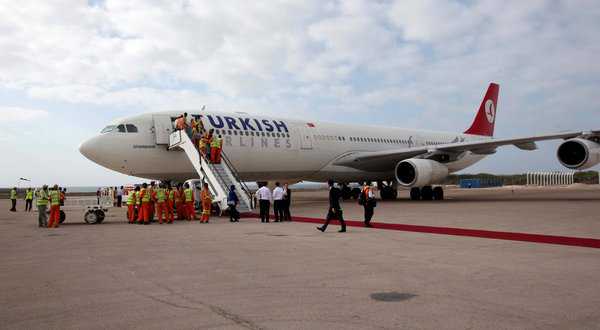
On March 6, 2012, a Turkish Airlines plane landed at Aden Abdulle International Airport in Somalia’s capital Mogadishu, a new addition to its list of nonstop destinations. Turkish Airlines flies to more cities nonstop than any other European or Middle Eastern airline, but some in the industry feel it is growing too quickly.
By CHRISTINE NEGRONI
Published: March 14, 2012
Which European or Middle Eastern airline flies to the most destinations nonstop? If you said Air France or Emirates, you would be wrong. Ditto for British Airways or Etihad. The answer is Turkish Airlines, which offers direct flights to 189 destinations from Istanbul — 15 more than Lufthansa offers from its giant hub in Frankfurt.
According to anna.aero, an airline route-tracking Web site, Turkish is not just adding destinations at a rapid clip, it is adding passengers, too. Over the 10 years to 2010 it tripled the number of air travelers carried, with increased traffic to North America and Asia playing a large role. Turkish Airlines’ growth is yet another example of what some in the industry are calling the aviation industry earthquake.
“Look at the whole globe and see we always have countries or economies that are growing,” said Horst Findeisen, vice president of business development for the Star Alliance, of which Turkish is a member. “Turkey sits in an area where growth is still occurring, and it is developing routes to accommodate that traffic,” he said in a phone interview.
In this respect, Turkish is sometimes lumped with Emirates, Etihad and Qatar, the Gulf carriers that have added airplanes and routes to take advantage of their geographical position linking the developing aviation markets of India and China with North America and Europe. These carriers have grown quickly in a short amount of time. But their business is entirely international.
With a geographical area of about 775,000 square kilometers, or 300,000 square miles, and a population of 72 million, Turkey is much larger than either the United Arab Emirates or Qatar, and it has 43 domestic airports. Nearly half of Turkish’s customers are traveling within the country. “In the Gulf they don’t have the local market,” said Temel Kotil, chief executive of Turkish. “We have a strong domestic market. We have a strong point-to-point market, and transfers are additional.”
Turkey’s closer proximity to Europe also allows it to offer service in narrow-body aircraft, which are not as expensive to operate and do not need as many passengers to turn a profit, said Ali Genc, the airline’s senior manager of media relations. “We can go into thinner markets, and penetrate all of Europe’s second- and third-tier markets, which you can’t do with larger airplanes,” he said, citing as examples flights to Glasgow and Edinburgh in Scotland and Coventry and Liverpool in England.
What Turkish shares with the Gulf carriers is a government that encourages the airline for what it can do to promote the country globally. And while Qatar, Etihad and Emirates are owned by their governments, and Turkish was privatized in 2006, in many ways the airline can rely on assistance from Ankara, said Nawal Taneja, a professor of aviation in Ohio who writes about the industry.
“Government facilitates the development by setting the regulatory policies to get rights, helping Turkish develop the infrastructure and facilitating credit to get planes purchased,” Mr. Taneja said.
In 2012, Turkish will open a new, 372,000-square-meter aviation services complex at Sabhia Gokcen Airport, 30 kilometers from Ataturk airport. It will run its maintenance and repair station in this new location and intends to enter the aircraft-seat manufacturing business there as well. The growth of the airline and of these and other related businesses means the company must add workers at a rate of 10 percent a year and add 250 pilots annually, Mr. Kotil said.
But the question some are asking is whether Turkish is moving too fast.
“They’re high on the fumes of growth,” said Vaughn Cordle, an airline economist with Airline Forecast in Washington. “If you grow too fast and invest too much in customer value, you destroy stockholder value.”
Turkish Airlines’ net profit slid in 2010 to 286.4 million lire, equivalent to $184 million at the time, from 559.1 million lire in 2009, a drop attributed by Mr. Kotil to heavy losses in the first three quarters of 2010, as the airline opened new routes and took delivery of billions of dollars’ worth of new airplanes fitted with amenities like lie-flat business class seats. In the first half of last year, the airline reported a further loss of 527.4 million lire.
Still, Mr. Kotil said, growth would allow the airline to begin enjoying economies of scale. “All those extra routes cost you money because they are not making profit from day one,” he said. “You put new routes in order to reinforce the network and make it attractive for the customer and make them choose you.”
In this respect, Mr. Kotil acknowledged, passengers will no longer blindly buy tickets on their national airline.
Turkish fliers do not have to choose Turkish Airlines, he noted. “They can move to other airlines. There is no captive market at all. If you don’t have the product, forget about it.”
via Turkish Airlines Maintains Policy of Rapid Expansion – NYTimes.com.

Leave a Reply